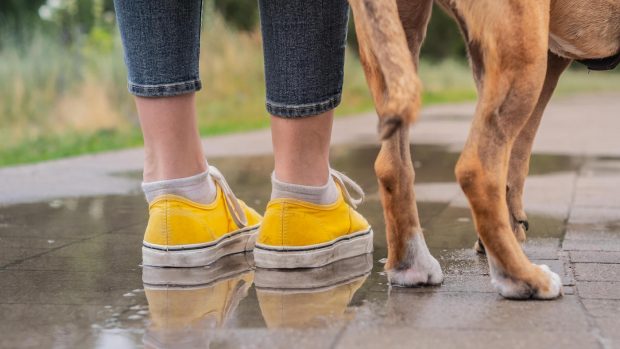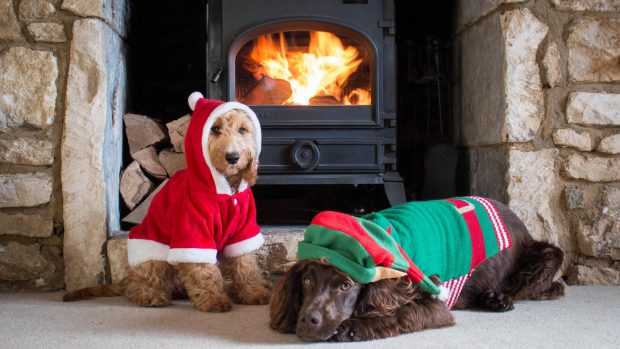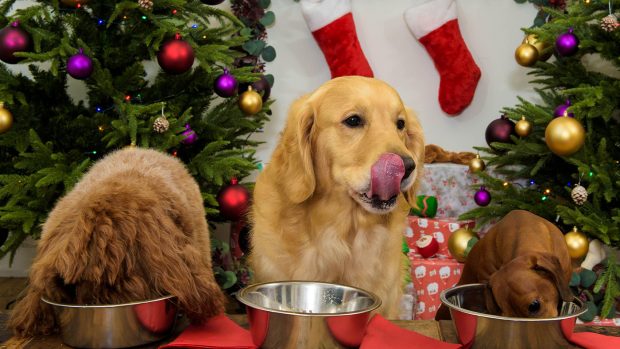The issue of reactivity in dogs is massive and affects thousands of dogs and their owners. It can be upsetting, stressful and isolating for you, as well as stressful for your dog. The problem is not helped by uneducated, rude and judgmental people, especially during times the dog is reacting.
Understanding of your dog’s fears and triggers should be the aim of all dog owners. Dogs have different personalities, so will have different fears and triggers, and what may work for one dog won’t necessarily be the same for another who has the same trigger response. There is no “one size fits all” technique. I have learnt a lot from a wonderful book called Canine Body Language by Brenda Aloff (which is available on Amazon). I believe that if all dog owners read this book, the canine world would be a better place – and if I was a betting person, I’d bet reactivity would be halved.
Safety is our primary concern and, at a minimum, it is our responsibility to keep our dogs from threatening or hurting other people or animals. And, of course, our dogs will be a lot happier not to be stressed out.

Canine Body Language | Amazon.co.uk
This book comes recommended by H&H’s dog behaviour expert. It’s full of photos and detailed explanations to help you interpret you dog’s emotions and thoughts.
Why can dogs be reactive?
There are lots of reasons a dog may be reactive as well as several types of reactivity. Lead reactivity, which is most commonly seen when a dog is barking or lunging when it sees another dog coming towards it or near it, usually occurs because the dog is afraid (showing fear aggression) and has anxiety issues. It could also be defensive aggression, which is when a dog is appearing to be aggressive to ward off the threat (the other dog) before it has a chance to interact with him. Aggression can also be directed to a certain breed – for example, if the dog has been attacked (particularly during a puppy fear period) by a specific breed of dog. Dogs do not forget trauma or what caused it.
There is no safer place for a dog than its home, garden and even the car. This can cause a dog to be highly reactive to new people or animals entering their environment or the perceived threat of someone walking past the garden gate or passing them while in the car. Dogs have thoughts feelings and emotions and are usually battling anxiety and/or confusion among other emotions, and aggression is a coping mechanism. Unlike us, they cannot rationalise a situation and their only way of expressing how they feel is to be vocal or physical. It is our duty to stop that behaviour and help them.
What happens when a dog is reactive?
Dog aggression is not simply a behaviour as it includes an internal set of emotional and physiological responses each time it occurs. Many of these responses are involuntary. When a dog behaves aggressively there is a release of dopamine, which is associated with pleasurable feelings – and this offsets the sense of dread that anxiety and fear produces.
These complications are why punishment-based techniques are usually not effective long term, and why simply trying to give treats to a dog usually does not work too well either. You will need to have some understanding of what is going on underneath the behaviour to adjust their issues and feelings. You need to understand that the dread produced because of anxiety is not a choice and that the anxiety makes them feel they need to do something about it urgently.
Signs of reactivity in dogs
There are many physical signs that a dog is ready to react, and it is surprising that so many owners do not see them. Let’s start with the obvious signs:
- Growling, barking, and snarling at the trigger
- Stiff body posture, sometimes the heckles are raised (please note, heckles are not always a sign of aggression or reactivity)
- Suddenly stopping and eyeballing braced legs
- Whale eyes, dilated pupils
- Stiff tail
- Lowered head
Less obvious signs that are most commonly missed or dismissed include:
- Scanning
- Panic pacing, constantly fidgeting or pulling to be on the move to self soothe or get away from a trigger
- Panting and tongue far out
- Facial tension
- Dander
- Excessive sniffing
- Tongue flicking
- Displacement behaviour to avoid reactivity (e.g. scratching, squinty eyes, hiding)
What causes reactivity?
Reactivity in dogs can happen for numerous reasons, including:
- trauma in the fear periods
- abuse
- being attacked
- over-exposure to situations that the dog is fearful of
- use of the wrong equipment
- not understanding your dog’s body language and, therefore, missing opportunities to prevent them from becoming reactive
If your dog is being aggressive, he is stressed and the physiological responses that have occurred in response to the stress do not disappear right away. Some changes last for hours, others for days, and some for weeks. Chronic stress can make dogs unable to regulate and respond to future stressors, which can make aggression a vicious circle. Stressful situations include:
- People petting your dog when they do not want to be petted. Do the consent test. Pet your dog for a few seconds and then move away. A dog that wants to be petted will make it really obvious. If they stand there without approaching you, they are only tolerating it. If they turn their head away, move away from the petter or lick their lips, then they may be actively stressed by it. If you do not stop people from touching your dog, the only option left for your dog is to back away. If that does not work, they may escalate to a bark, then a growl and then, failing complete lack of guidance and care by you, bite the person trying to stroke them.
- Unpredictable occurrences. Your dog is unable to predict when things happen – good or bad – and this can be stressful. Build in signals that prepare your dog for when things are going to happen as long as it does not cause anticipatory anxiety for your dog.
- Your dog being exposed to anything that makes them feel anxious. For example, if your dog has a fear of thunderstorms, talk to a vet. If your dog hates nail trims, desensitise and counter condition them to make it easier for them.
It’s unfortunate that fear is not forgotten. Extinction, however, is a relearning process where learned fear response is the gradually weakened. It takes a lot longer to make a response extinct than it does to learn it in the first place. Fear responses that are thought to have become extinct can re-appear over time, if the dog is under stress, or if the part of the brain that is involved in inhibiting the fear response is otherwise occupied on another mental task. For this reason, is important to continue to monitor our dogs for stress and anxiety even after significant improvement has been made in our dog’s aggression problem.
How to deal with reactivity in dogs
1. Environmental control
If you do nothing else, you should be discontinuing or avoiding doing whatever causes your dog to become anxious or aggressive to control your dog’s environment in such a way that he is not exposed to the circumstances that cause the problem behaviour. This minimises the dog practising the aggression, reduces stress and improves safety for all.
A dog’s brain adapts according to what brain areas we use. The more a dog is exposed to the things that trigger his aggression, the more efficient his brain will become in responding his typical way and the more entrenched those behaviours will continue to become. This can be overcome with patience, consistency with the right corrections and praise at key moments.
I am a big believer in coping strategies and taking the pressure off. I do not recommend forcing your dog to face perceived negative situations daily as this only affirms the fear and anxiety, and your dog will be hyper alert the minute you set off. I also believe that dogs should never be worked with anything round the neck i.e a flatbed collar, slip lead or half check (and obviously not a choke chain or pinch collar) – instead I would recommend a front-loading harnesses.

Halti No-Pull Harness | Amazon.co.uk
This fully adjustable no-pull solution has both a no-pull lifting action and front control steering. It’s also a great option for flat-nosed breeds who can’t wear a headcollar.

PetSafe Training Harness | Amazon.co.uk
This padded front-loading harness minimises your dog’s pulling by gently steering him in the right. It safely controls light to moderate pulling by resting across your dog’s chest instead of his throat, preventing choking, gagging or coughing.

Halti Front Control Harness | Amazon.co.uk
This front-loading harness has two points of connection for extra control, benefits from neoprene padding and has five points of adjustment to get the perfect fit.
Sound and feel therapy are a huge part of reactive work. When your dog enters that red mist zone and becomes totally fixated (limbic), he’s so focused and fuelled by adrenaline and the fight or flight instinct, that he is desensitised to all its surroundings, including your voice. Different sounds can be used to snap them out of it for you to then engage them, correct and redirect the behaviour, while offering reassurance and a presence to “environmentally” control the situation.
2. Reduce stress
Stress is inevitable in life, but chronic stress causes several changes in the body that impact our health long term and alter the chemical balances in the brain making it more difficult to cope with additional stress. The older you are, the longer it takes to recover from stress and for our body to return to a state of equilibrium. Reactive dogs are already finding coping with the world challenging. In order for our dogs to be able to continue with rehabilitation, it is important to know when to push and when the pressure needs to come off. This is a very fine line and the harsh reality is that most owners do not take the prevention of their dog’s anxiety seriously enough.
To help reduce stress for your dog you can:
- Provide stability and predictability in his world
- Exercise (but not at the expense of stressing him out further)
- Change the diet – 85% of behavioural issues I see are food related so feed the highest quality food you can – what you put in is what you get out
- Dot be afraid to use supplements – Rescue Remedy (available from Amazon), CBD oil (available from your vet), serotonin and tryptophan (such as YuMove Calming Care) are my favourites. Adaptil spray and Adaptil plug-ins (available from Amazon) are also quite effective.
- Obedience training to reduce the dog’s confusion about what the humans expect of them
- Chewing and the use of lick mats (like this one on Amazon) helps release dopamine, which is the feel good hormone, which is why dogs chew doors, furniture or shoes
- Ensure your dog has a safe space in the house when visitors arrive

Bach Rescue Dropper | Amazon.co.uk
Uses natural flower essences to help ease tension, nervousness and excitability in dogs, cats, horses, rabbits and birds.

YuMove Calming Care | Yumove.co.uk
This supplement is an effective way to help reduce stress, support calm behaviour and ease anxiety. Contains L-tryptophan. Also available at Amazon.

Adaptil Calming Plug-in | Amazon.co.uk
This spray contains a synthetic copy of the “dog appeasing pheromone”, which a mother naturally releases to calm and reassure her litter.

Adaptil Spray | Amazon.co.uk
Contains a synthetic copy of the ‘dog appeasing pheromone’, which a mother naturally releases to calm and reassure her litter. Can be sprayed on bed or blanket.
3. Be the safe person
Part of helping your dog overcome fear, aggression and anxiety is to take control and ensure your dog doesn’t feel vulnerable, exposed or worried. I’m a big believer in body language. There is no such thing as a pack leader, but dogs do understand a hierarchy system.
Do not allow your dog to jump at you, pull you from side to side, control your movement or your pace because if a dog learns to move you, he will consider himself above you in the hierarchy and, therefore, will be in control of his environment. When you establish yourself as higher in the hierarchy, your dog will respect you, love you, and start to feel safe in the knowledge that you will deal with the situation so that they do not have to. You now have the beginnings of the trust bond. In a stressful situation, my dogs run to me as their safe person rather than bolt away to self-preserve.
How to prevent reactivity in dogs
In some cases reactivity can be prevented if you’re aware of your dog’s body language and signals, as well as the stimuli, places, and events that he finds stressful. This brings you halfway to preventing negative experiences that become fear forming. I recommend that you:
1. Be proactive not reactive. Stop the behaviour before it starts by teaching your dog what you want it to do. If we don’t do this, your dog will make the decision that they believes keep them and, in some circumstances, both of you, safe.
2. Control all the situations your dog is in. He looks to you for guidance and to keep him safe. If you fail in this aspect, you will lose your dog’s trust and he will enter the self-preservation mode. Stop them scanning, panic pacing and stalking. Remove them from stressful situations or create a bigger distance until the confidence is such that you can move closer or deal with environments of difficulty.
Reactivity is complex, and dogs present a variety of different behaviours. A good example is a Rottweiler I work with. He is the sweetest boy, loves people, and while off the lead he loves all dogs and plays beautifully. On the lead, however, he is an absolute monster, is extremely aggressive at the vets, and he once bit me due to redirected fear aggression. But he then spent the next 10 minutes licking me to death when removed from the stressor (the vet). While you can learn a massive amount from Canine Body Language and by reading articles like mine (find them all here), it is always better to have a hands-on consultation with a qualified behaviourist at the first signs of aggression problems. This way, if caught early enough the matter can be dealt with if not fully resolved before things get out of hand.
You might also like:

Soothe anxiety with the best calming supplements for dogs

How to help an anxious dog

No more yapping: how to stop a dog nuisance barking

How to master loose lead walking

How to prevent and deal with separation anxiety in dogs: practical advice from an expert

Subscribe to Horse & Hound magazine today – and enjoy unlimited website access all year round
Horse & Hound magazine, out every Thursday, is packed with all the latest news and reports, as well as interviews, specials, nostalgia, vet and training advice. Find how you can enjoy the magazine delivered to your door every week, plus options to upgrade your subscription to access our online service that brings you breaking news and reports as well as other benefits.




